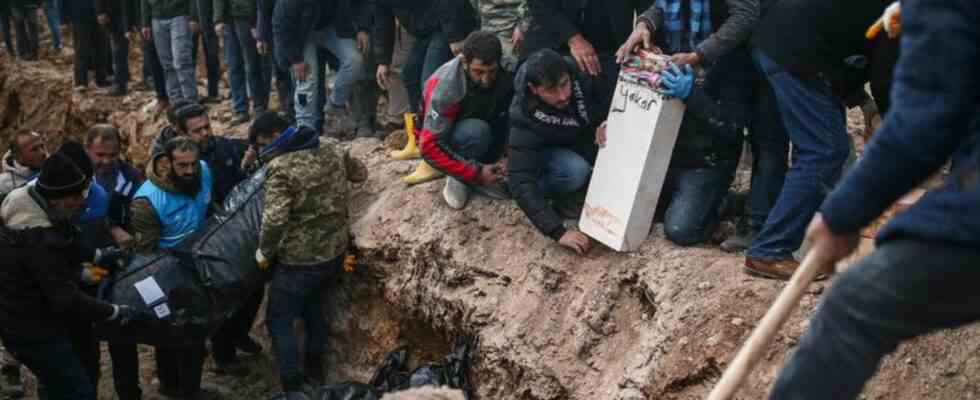Rescuers are still searching for people under the rubble. But with every hour the hope of meeting survivors decreases. The freezing temperatures are especially dangerous for children.
Even with concrete figures, the catastrophe can hardly be grasped: more than 22,000 people have lost their lives as a result of the earthquake catastrophe in Turkey and Syria. Thousands more deaths are feared.
The United States has promised aid worth millions, both for NATO partner Turkey and for Syria. There, in Aleppo to be precise, ruler Bashar al-Assad presented himself publicly for the first time since the accident.
Hoping for miracles in the rubble
On both sides of the border, the rescuers are still fighting for every life. “We will continue until we are sure that there are no survivors left,” a reporter for Turkey’s state television channel TRT World quoted a spokesman for the emergency services as saying on Friday.
And in fact there are still reports of almost unbelievable rescues. In southeast Turkey, a family of six was recovered alive after 102 hours under the rubble. The parents with their children between the ages of 15 and 24 were taken to the hospital, the state news agency Anadolu reported. A neighboring couple from the same building was rescued after 107 hours.
Also after more than 100 hours, a ten-year-old was rescued from a collapsed house in the city of Kahramanmaras, the Israeli military said on Friday. The rescue operation lasted about an hour.
Swiss helpers also reported a miracle: they rescued a six-month-old baby and his mother alive from the rubble in Hatay on Friday morning. The Swiss Humanitarian Aid Unit (SHA) worked there together with local partners. With the help of Swiss search dogs, eleven buried people were rescued alive, the SKH spokeswoman said.
It is a miracle to recover someone who is still alive after such a long time. Only in rare cases does a person survive more than three days without water. Add to that the freezing temperatures.
“How long you can survive in such a situation depends on many factors: weather, water supply, physical constitution,” says Professor Bernd Böttiger, federal doctor of the German Red Cross and director at the University Hospital in Cologne. “The environmental conditions of winter temperatures affect children in particular. They cool down faster than adults.”
Aid flights of the Bundeswehr started
After the quake, more and more help is pouring in from abroad. More than 7,000 helpers from 61 countries are in Turkey, the Foreign Ministry said in Ankara on Friday. NATO said it would send mobile emergency shelters equipped with heaters, power generators and medical treatment areas. A naval ship with relief supplies and a field hospital is on its way from Italy, it has four intensive care beds.
The US wants to provide 85 million dollars (about 79 million euros) for Turkey and Syria. The aid should include food, shelter, medicine and family care, wrote US President Joe Biden on Thursday (local time) on Twitter. The World Bank announced it would provide Turkey with US$1.78 billion (€1.65 billion) in assistance.
Germany also promised further aid deliveries. “We are on Turkey’s side,” said Federal Interior Minister Nancy Faeser on Friday at the Wunstorf military airport near Hanover, which she visited together with Federal Defense Minister Boris Pistorius (both SPD). “We fly as long as necessary,” emphasized Pistorius. “This will continue to be the case for the next few days.” The main supplies are tents, beds, sleeping bags, blankets, heaters and generators.
More than 77,000 injured in Turkey
The number of deaths in both countries is increasing rapidly. In Turkey alone, 19,338 deaths were counted, and the number of injured was more than 77,000. 3,384 deaths were recently reported from Syria. At least 22,722 fatalities have now been counted in both countries, with many more feared.
“We are facing a catastrophe that is worse than the days of war,” said a woman named Suad in Aleppo to the German Press Agency.
More than 1000 aftershocks
The first quake had shaken the border area early Monday morning with a magnitude of 7.7. Another 7.6 magnitude tremor followed in the region at noon. According to the Turkish civil protection agency Afad, there have been more than 1,000 aftershocks since then.
President Assad and his wife Asma visited victims of the earthquake at a clinic in Aleppo on Friday, the Syrian presidency said. She also published photos showing the two at the bedside of the injured.
In the civil war that broke out in 2011, Assad brutally attacked his own people. He is accused of crimes against humanity, including the use of chemical weapons. His government now controls around two-thirds of the fragmented country again, including Aleppo.
The political situation in Syria is particularly difficult for the helpers. The problem is that the government and its troops have not recently allowed any humanitarian aid into the country ravaged by civil war, said German Foreign Minister Annalena Baerbock (Greens) on WDR radio.
According to the UN Organization for Migration (IOM), the first UN convoy of six trucks sent from Turkey arrived in the rebel region on Thursday evening. On board were blankets, mattresses, tents, solar lamps and other things for at least 5000 people on board. A second convoy of 14 trucks crossed the border on Friday morning and was on its way to Idlib, an IOM spokesman in Geneva said.

